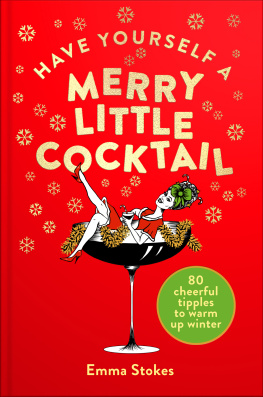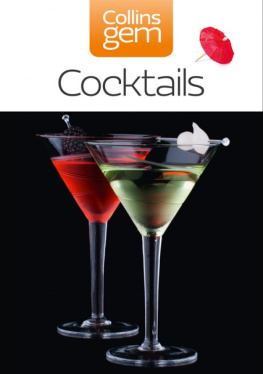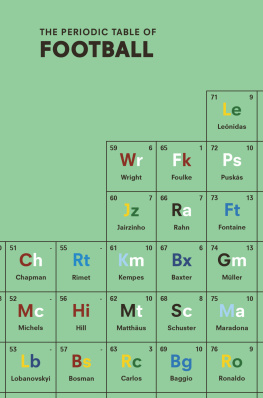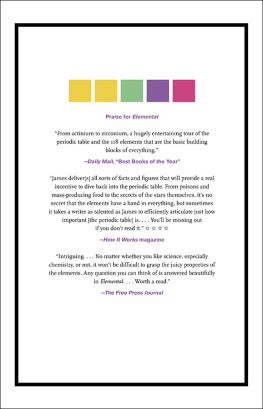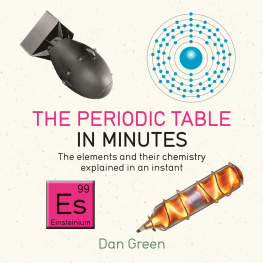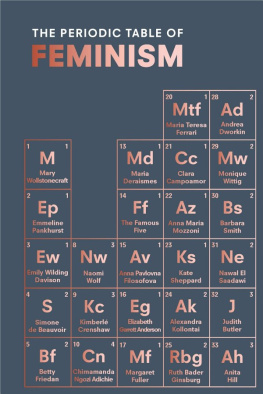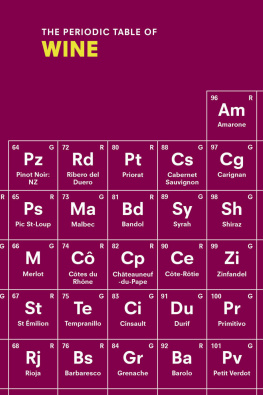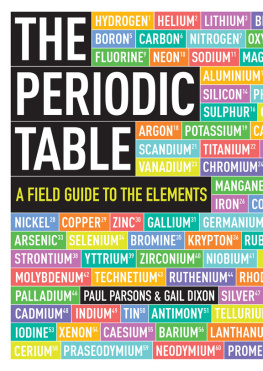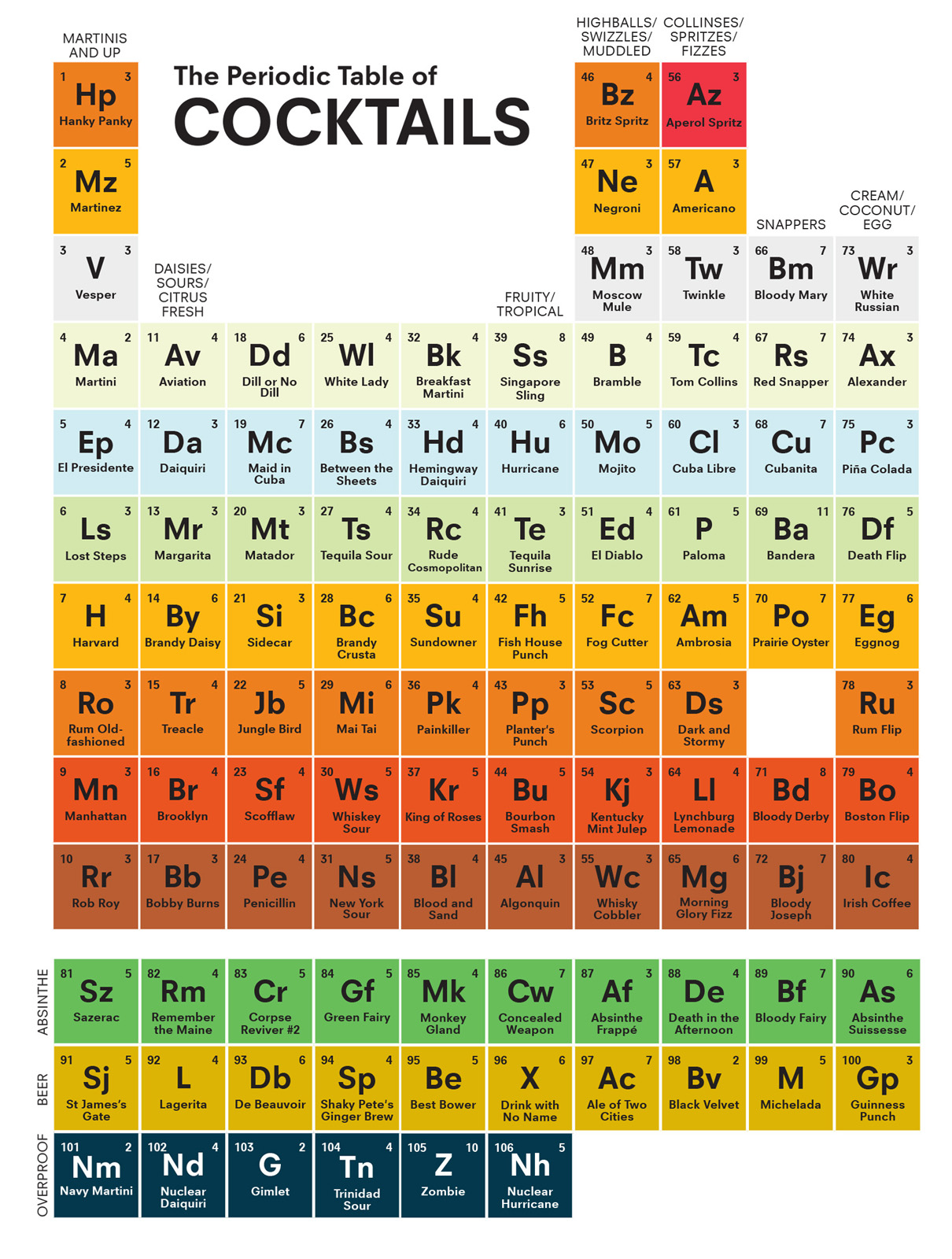
You can never take what you love too seriously...

The Periodic Table Series
Periodically, were all geeks about the things we love and the Periodic Table Series has been created to celebrate this universal fact.
Inspired by The Periodic Table of Chemical Elements*, our experts have applied scientific logic to an eclectic range of subjects that regularly baffle beginners and fire-up fans. The outcome of this experiment is the essential guide you hold in your hand.
Geeky? Absolutely.
Hugely satisfying? Categorically.
*The Periodic Table of Chemical Elements orders all the known matter that makes up our world, from hydrogen to helium, by chemical properties and behavior to give scientists a handy overview of a rather complex subject.
... Because its always five oclock somewhere!

Editor: David Cashion
Design Manager: Devin Grosz
Production Manager: Kathleen Gaffney
Library of Congress Control Number: 2016945956
ISBN: 978-1-4197-2407-7
eISBN: 978-1-68335-045-3
Copyright Ebury Press 2015
Illustrations Hennie Haworth 2015
Published in 2017 by Abrams Image, an imprint of ABRAMS. All rights reserved. No portion of this book may be reproduced, stored in a retrieval system, or transmitted in any form or by any means, mechanical, electronic, photocopying, recording, or otherwise, without written permission from the publisher.
Abrams Image books are available at special discounts when purchased in quantity for premiums and promotions as well as fundraising or educational use. Special editions can also be created to specification. For details, contact specialsales@abramsbooks.com or the address below.

ABRAMS The Art of Books
115 West 18th Street, New York, NY 10011
abramsbooks.com
Contents

Introduction
Welcome to The Periodic Table of Cocktails. The idea behind this book is to organize more than a hundred cocktails into a map of sorts, allowing you to explore the various types and categories of cocktails in terms of their similarities, but also their points of difference.
Ive included classic cocktails steeped in history alongside modern classics that feature on menus in bars the world over, as well as a few ultra-modern creations that you may not have heard of yet, but soon will.
Organizing information into an easy-to-read format is a huge business. Look at any topic and its likely youll find a number of infographics that have been created to explain or explore the subject matter. The periodic table was perhaps one of the first examples of this, grouping and organizing chemical elements so that their similarities were easier to see, and trends easier to deduce. As someone with a scientific background, the concept of using this structure to organize cocktails (my second love in life), was both a challenge and a joy.
Periodic tables of cocktails that have come before this book tend only to scratch the surface of what is possible, mostly just using the fact that a table is a cool way to display a number of cocktails. What Ive done here is take the principles behind how the original structure of the periodic table organized the elements and apply them to cocktails to come up with something that not only looks good but also makes it easy for people to explore a multitude of mixed drinks.
Cocktail culture started in a time when global communications werent that well established, so pockets of the world were innovating and growing alongside each otheroften at the same time at different points on the globe, particularly in London and New York. This means that there is often confusion about where some of the classics originated, what exactly is in them, and how they should be served. Some fantastic cocktails that appeared in classic cocktail books such as Harry Craddocks The Savoy Cocktail Book (1930) or Jerry Thomass The Bartenders Guide: How to Mix Drinks, or The Bon Vivants Companion (1862) were not lucky enough to have been immortalized by a fictional British secret agent or womanizing ad man. This book was therefore an opportunity to research the history of these drinks and to draw attention to those from past and present that I think equally deserve to be known. The goal: delicious cocktails with interesting stories and/or heritage.
The cocktail category is huge. There are so many spirits, liqueurs, juices, and other ingredients that the possibilities are endless. With thousands of such possibilities, it can be daunting to know where to begin with a cocktail menu. What I hope is that, by using the table, people will be able to start with cocktails they know and love, and then move around the table to discover new drinks, with the flavors evolving as they goyet still maintaining similar features to the previous drink.
How does the table work?
Each element in the table is a distinctive cocktail. They are grouped into styles of cocktails in columns and by predominant base alcohol across the rows (the periods). The cocktails get longer (greater in volume) as you progress from left to right across the table, from the first column of martinis all the way to the collinses, fizzes, and snappers on the far right. In the rows, the spirits or liqueurs become heavier as you move down the table. Youll therefore find vodka- and gin-based cocktails at the top, and bourbon- and whiskey-based cocktails toward the bottom.
The aim of all of this is that if you like one cocktail in the table, you should like all the cocktails that surround it, as they will be of similar style and/or use a similar or the same base spirit. Next time youre glancing at a cocktail menu or working out what to concoct at home, youll hopefully have the confidence to try something new and the knowledge to choose a little more wisely.
The three categories at the bottom of the table, termed the rare earth elements on the original periodic table and separated from the main table, contain the more unusual types and styles of cocktails. They follow the same principles as the columns in the main table, so they get longer as you move from left to right, but rather than a predominant base spirit, they have other traits in common: the use of absinthe, beer, or overproof spirits.
I hope you enjoy testing the table.
Cheers!


The cocktails in the first column of the table that are contained within this chapter can all be classified as martinis or cocktails that are served straight up (i.e., with no ice). Theyre pretty serious in terms of their booze-heavy makeup, so you wont find any mixers or citrus here (with the exception of the Harvard, which has a dash of soda in it).
Next page

